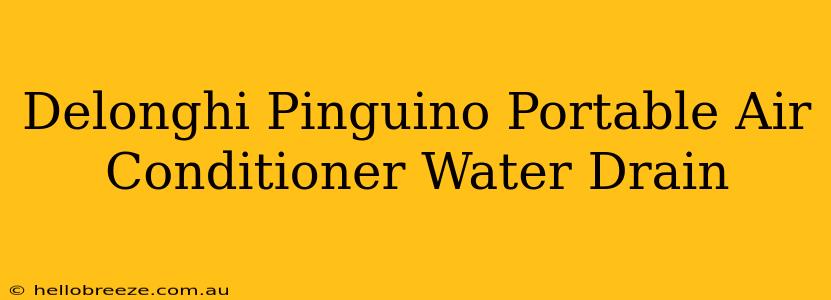The DeLonghi Pinguino is a popular choice for portable air conditioning, offering effective cooling in a compact design. However, like all air conditioners, it produces condensation that needs to be managed. Understanding and properly utilizing the water drain feature is crucial for keeping your Pinguino running smoothly and efficiently. This guide will walk you through everything you need to know about draining your DeLonghi Pinguino portable air conditioner.
Understanding Condensation and Water Drainage
Portable air conditioners work by removing heat and humidity from the air. This process creates condensation, which collects in a reservoir inside the unit. If this reservoir fills up, the air conditioner will automatically shut down to prevent overflow. This is a safety feature designed to protect your unit and your home from water damage.
Types of Water Drainage Systems in DeLonghi Pinguino Models
Depending on your specific DeLonghi Pinguino model, you might have one of two drainage systems:
- Internal Reservoir: Many Pinguino models use an internal reservoir that needs to be manually emptied. When the reservoir is full, the unit will usually alert you with a warning light or sound.
- Continuous Drainage: Some higher-end Pinguino models offer a continuous drainage system. This allows you to connect a hose to the unit, directing the condensation water to a drainpipe or other suitable location. This eliminates the need for frequent manual emptying.
How to Drain Your DeLonghi Pinguino Air Conditioner
The process for draining your Pinguino depends on whether it has an internal reservoir or a continuous drainage system.
Draining the Internal Reservoir
- Turn off and unplug the unit: This is a crucial safety step before performing any maintenance.
- Locate the water reservoir: Consult your user manual for the exact location; it's usually accessible from the back or bottom of the unit.
- Carefully remove the reservoir: Follow the instructions in your manual; this often involves pulling a handle or releasing a latch.
- Empty the reservoir: Carefully pour the water into a suitable container.
- Clean the reservoir: Rinse the reservoir with clean water and allow it to dry completely before reinstalling it.
- Reinstall the reservoir: Make sure it's securely placed back into the unit.
- Plug in and turn on the unit: Your Pinguino should now be ready to cool again.
Using the Continuous Drainage System (if applicable)
- Turn off and unplug the unit: Safety first!
- Locate the drain port: Refer to your user manual for the exact location and type of connector.
- Attach a suitable hose: Use a hose with an appropriate diameter to connect to the drain port.
- Direct the hose: Route the hose to a suitable drain, such as a floor drain or a container outside.
- Turn on the unit: The condensation will now continuously drain through the hose.
Troubleshooting Common Water Drain Issues
- Unit shutting down frequently: This usually indicates a full water reservoir. Empty it according to the instructions above.
- Leaking: Ensure the reservoir is properly seated or that the hose connection is secure (if using continuous drainage). Check for any cracks or damage to the reservoir or tubing.
- Water not draining: Check for blockages in the drain hose (if applicable). Ensure the hose is properly connected and the drain is not obstructed.
Maintaining Your DeLonghi Pinguino for Optimal Performance
Regular cleaning and maintenance are essential for keeping your DeLonghi Pinguino running efficiently and preventing issues with the water drain. Always refer to your user manual for specific cleaning recommendations and safety precautions. By following these simple steps, you can keep your DeLonghi Pinguino performing at its best and enjoy cool, comfortable air all season long. Remember, a well-maintained unit will require less frequent draining and is less likely to experience problems.

